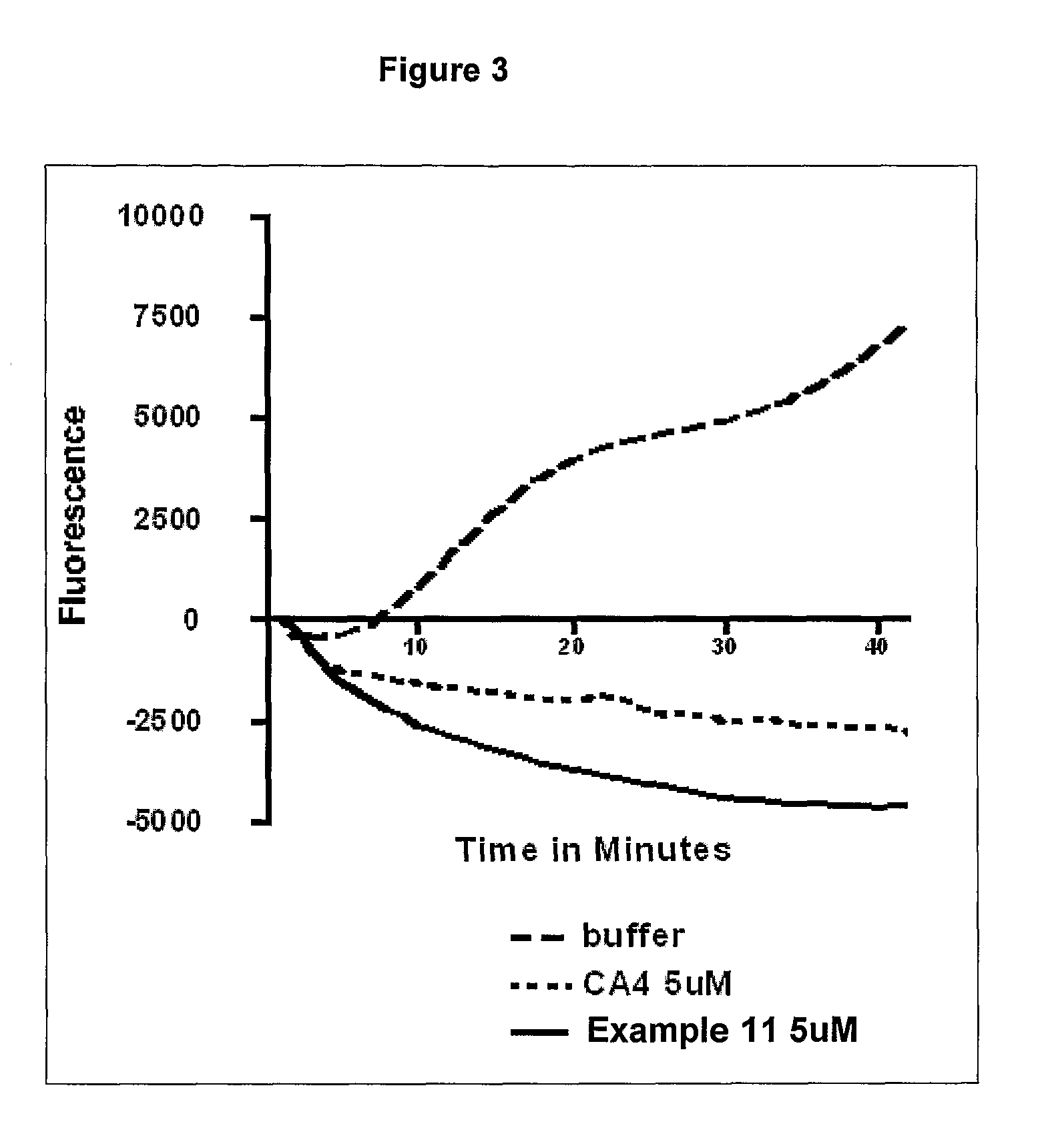Substituted benzofurans, benzothiophenes, benzoselenophenes and indoles and their use as tubulin polymerisation inhibitors
a technology of benzofurans and benzoselenophenes, which is applied in the field of chemical compounds, can solve the problems of changing endothelial cell morphology, cell death by an apoptosis mechanism, and tissue damage, and achieve the effect of inhibiting tubulin polymerisation
- Summary
- Abstract
- Description
- Claims
- Application Information
AI Technical Summary
Problems solved by technology
Method used
Image
Examples
example 1
Preparation of (6-Methoxy-7-nitrobenzofuran-3-yl)(3,4,5-trimethoxyphenyl)methanone
[0242]
Step 1: 2-Nitro-3-methoxyphenol
[0243]To a mixture of 2.01 g (1.3 mmol) of 2-nitroresorcinol in 15 ml of dry pyridine 0.28 ml (1.36 mmol) of acetic anhydride was added dropwise at 0° C. The resulting mixture was allowed to warm to room temperature. After 1 h of stirring at room temperature the solvent was removed by evaporation in vacuo and the residue diluted to 10 ml with anhydrous acetonitrile. To this 2 g of anhydrous potassium carbonate was added followed by the addition of 1.5 ml of methyl iodide. The resulting suspension was stirred overnight at room temperature, filtered off and filtrate evaporated to dryness under reduced pressure to give 2.63 g of crude 3-methoxy-2-nitrophenyl acetate. This was dissolved in 15 ml of acetonitrile and 2 ml of concentrated ammonium hydroxide was added. The resulting mixture was allowed to stand for 30 minutes at room temperature and evaporated to dryness un...
example 2
Preparation of (7-Amino-6-methoxybenzofuran-3-yl)(3,4,5-trimethoxyphenyl)methanone
[0251]
[0252]A mixture of 0.022 g (0.057 mmol) of (6-methoxy-7-nitrobenzofuran-3-yl)(3,4,5-trimethoxyphenyl)methanone, 0.1 g of ammonium formate and 0.1 g of 10% palladium on carbon in 5 ml of a mixture of 1,2-dimethoxyethane and methanol (4:1) was refluxed for 30 minutes (TLC controlled reaction). After cooling to room temperature the mixture was filtered through a pad of Celite and washed with methylene chloride. The filtrates were evaporated to dryness under reduced pressure and the residue was purified by flash column chromatography to give 0.011 g (55% yield) of pure title compound as a colorless solid; 1H NMR (CDCl3) δ 3.89 (s, 6H, OMe); 3.92 (s, 6H, OMe); 4.01 (broad s, 2H, NH2); 6.95 (d, 1H, CH aromatic, J=8.54 Hz); 7.14 (s, 2H, CH aromatic); 7.46 (d, 1H, CH aromatic, J=8.54 Hz); 8.0 (s, 1H, CH furan).
example 3
Comparator D
Preparation of 2-Bromo-3-(3,4,5-trimethoxybenzoyl)-6-methoxybenzofuran
[0253]
Step 1: tert-Butyldimethylsilyl-3-(t-butyldimethylsilyloxymethylene)-6-methoxybenzofuran (Larock coupling)
[0254]A suspension of 2-iodo-5-methoxyphenol (1.1 g, 4.41 mmol), 1-(tert-butyldimethylsilyl) -3-(tert-butyldimethylsilyloxy)propyne (1.5 g, 5.28 mmol), lithium chloride (189 mg, 4.45 mmol) and sodium carbonate (2.34 g, 22.08 mmol) in dry dimethylformamide (5 mL) at 100° C. was deoxygenated 4 times by evacuation and backfilling with nitrogen. Palladium acetate (135 mg, 0.60 mmol) was added and the reaction vessel was degassed twice with nitrogen. The reaction mixture was then stirred at this temperature for 4 hours (monitored by tlc) and the solvent was removed by distillation under vacuum. The residue was dissolved in ethyl acetate (75 mL), stirred well, filtered and treated with triethylamine (5 mL). The solution was concentrated onto silica gel (10 g) and purified by flash chromatography (s...
PUM
| Property | Measurement | Unit |
|---|---|---|
| temperature | aaaaa | aaaaa |
| volume | aaaaa | aaaaa |
| temperature | aaaaa | aaaaa |
Abstract
Description
Claims
Application Information
 Login to View More
Login to View More - R&D
- Intellectual Property
- Life Sciences
- Materials
- Tech Scout
- Unparalleled Data Quality
- Higher Quality Content
- 60% Fewer Hallucinations
Browse by: Latest US Patents, China's latest patents, Technical Efficacy Thesaurus, Application Domain, Technology Topic, Popular Technical Reports.
© 2025 PatSnap. All rights reserved.Legal|Privacy policy|Modern Slavery Act Transparency Statement|Sitemap|About US| Contact US: help@patsnap.com



